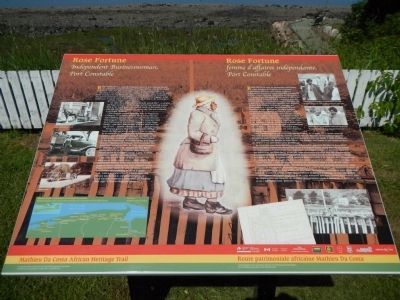Annapolis Royal in Annapolis County, Nova Scotia — The Atlantic Provinces (North America)
Rose Fortune
Independent Businesswoman, Port Constable
— femme d’affaires indépendante, Port Constable —

Photographed By Barry Swackhamer, June 17, 2014
1. Rose Fortune Marker
Captions (English / French):( left side, top to bottom) James Whitman Lewis, Sr.; James Abert Lewis, Jr.; Oscar Lewis; (map, red dot = trail sites) Historic Black Communities in Western Nova Scotia / Communautés noires de souche ancienne de l’ouest de Nouvelle-Écosse; (right side, top to bottom) Dr. Daurene Lewis, C.M. Mayor, Annapolis Royal, 1984-1988. / Dr. Daurene Lewis, C.M. Mairesse d’Annapolis Royal, 1984-1988.; Dr. Daurene Lewis, C.M. and her mother Mrs. Peryle Lewis. / Dr. Daurene Lewis, C.M. et sa mère, Mme Peryle Lewis.
Rose Fortune is a uniquely intriguing figure in Nova Scotia history. An independent businesswoman of African descent, she demonstrated remarkable character and indomitable resolve in her varied enterprises.
Operating a one-person transport company in early-1800s Annapolis Royal while keeping order on the town’s wharf as self-appointed Port Constable, she greeted passengers coming ashore and transported their luggage. Judge Halliburton, a regular client, relied on Rose to waken him in the mornings to get him to Digby in time for court.
An 1852 diary entry refers to Fortune (nearly 80) “…a curious of Negro woman …in man’s coat and felt hat: she has a small stick in her hand which she applied lustily to the backs of all who did not jump instantly out of her way. She was evidently a privileged character.”
This singular woman (possibly born in Virginia on 13 March, 1774) likely came to Nova Scotia with the slave-holding Davoue family (Devoe, Devout, Devone) following the American Revolution. The unnamed child in a 1784 Loyalist Muster roll (‘Fortune, a free Negro family .. one man, one woman, and one child over the age of 10’) ‘ …almost certainly refers to …Rose Fortune’.
Fortunes’s private life remains a mystery, though we know she had one or two daughters. She is regarded as an ancestor of Annapolis Royal’s Lewis family. James, an man of legendary strength, operated ‘James Lewis & Son’ (originally with brother Oscar, before he left for the railroad). With nine horses and wagons they provided general transport services: James’ son introduced a truck in 1931. In 1984, grand-daughter Dr. Daurene Lewis, C.M., became the first Black female mayor in North America, when she was elected mayor of Annapolis Royal. ‘Lewis Transfer’ continued until the late 20th century.
The only known image of Rose Fortune - an anonymous 1820 watercolour - illustrates an independent fashion sense. One Loyalist historian suggested Rose’s clothing may have reflected certain Black Loyalists’ relatively well-off status, modified by economic circumstances in ‘Nova Scarcity’.
St. Luke’s Anglican Church records show that Fortune was buried in an unmarked grave in Royal Garrison Cemetery (Annapolis), 29 February 1864 (age “unknown supposed about 90”).
French
Rose Fortune reste un personnage particulièrement intrigant de l’histoire néo-écossaise. D’ascendance africaine, cette femme d’affaires indépendante fit preuve d’une personnalité remarquable et d’une volonté farouche dans tout ce qu’elle entreprit.
À la tête d’une compagne de transport au début des années 1800 à Annapolis Royal, compagnie dont elle était le seul agent,
et tout en assurant la discipline sur le quai de la ville en tant que constable auto-désignée du port. Rose Fortune recevait les passagers que débarquaient et s’occupait du transport de leurs bagages. Le juge Halliburton, un client habituel comptait sur Rose pour le réveiller le matin, qu’il puisse arriver à Digby à temps pour paraitre en cour.
Une inscription dans un journal personnel daté de 1852 fait référence à Rose Fortune (alors âgée de pres de 80 ans); «une bien curieuse Négresse… vêtue d’un manteau d’homme et coiffée d’un feutre; une baguette à la main, qu’elle applique vigoureusement aux postérieurs de ceux qui ne s’écartent pas immédiatement de son chemin. De toute évidence une nature assez singulière .
Cette femme originale (que l’on croit née en Virginie, le 13 mars 1774) serait venue en Nouvelle-Écosse avec la famille Davoue (Devoe, Devost, Devone) et ses esclaves, après la Révolution américaine. L’enfant sans prénom que mentionne une feuille d’appel loyaliste de 1784 ( «Fortune, une famille de Noirs libres… un homme, une femme et une enfant de plus de 10 ans» ) est sans doute notre personnage.
Sa vie privée reste mystérieuse; nous savons toutefois que Rose eut une ou deux filles. On la considère comme une ancêtre des Lewis d’Annapolis Royal, parmi lesquels on compte un certain James, homme d’une force légendaire qui dirigea l’entreprise James Lewis & Son (au début avec son frère Oscar, avant que celui-ci ne parte Son service général de transport comprenait neuf voitures à cheval; le fils de James y ajouta un camion en 1931. Sa petite-fille, la docteure Daurene Lewis, C.M., fut élue in 1984 mairesse d’Annapolis Royal, devenant ainsi la première mairesse noire en Amérique de Nord. Quant à «Lewis Transfer», cette compagnie continua ses opérations jusqu’a la fin du XXᵉ siècle.
La seule représentation qu’il nous reste de Rose Fortune, une aquarelle anonyme de 1820, témoigne de son attitude désinvolte par rapport à la mode de l’époque. Un historien loyaliste est d’avis que les tenues de Rose reflétaient sans doute la condition relativement aisée de certains Noirs loyalistes, en tenant compte des conditions de pénurie à l’époque en Nouvelle-Ecosse.
Les registres de l’église anglicane de St. Luke indiquent que Rose Fortune fut inhumée dans un emplacement non identifié du cimetière de la garnison royal à Annapolis, le 20 février 1864 (à un age indéterminé, peut-être 90 ans ).
Erected by Mathieu Da Costa African Heritage Trail / Route patrimoniale africaine Mathieu Da Costa.
Topics. This historical marker is listed in these topic lists: African Americans • Women. A significant historical date for this entry is February 29, 1864.
Location. 44° 44.613′ N, 65° 31.193′ W. Marker is in Annapolis Royal, Nova Scotia, in Annapolis County. Marker is on St. George Street close to St. James Street, on the left when traveling north. Touch for map. Marker is at or near this postal address: 253 St George Street8, Annapolis Royal NS B0S, Canada. Touch for directions.
Other nearby markers. At least 8 other markers are within walking distance of this marker. Annapolis Royal Historic District (a few steps from this marker); Sir William Robert Wolseley Winniett. (within shouting distance of this marker); Sir William Fenwick Williams (within shouting distance of this marker); Masonic Stone of 1606 (within shouting distance of this marker); Major Erasmus James Philipps (about 120 meters away, measured in a direct line); Sinclair Inn (about 120 meters away); William Wolseley (about 120 meters away); Sieur de Monts (about 120 meters away). Touch for a list and map of all markers in Annapolis Royal.
Also see . . .
1. Mathieu Da Costa African Heritage Trail. The Mathieu Da Costa African Heritage Trail is the physical manifestation of the African Nova Scotian experience as it has unfolded within Western Nova Scotia. Further, the Trail is a celebration of African culture and history cultivated by unique individuals and strong communities that is all too often forgotten. (Submitted on November 6, 2014, by Barry Swackhamer of Brentwood, California.)
2. Mathieu de Costa - Wikipedia. Mathieu da Costa (sometimes d'Acosta) is the first recorded free black person in Canada. He was a member of the exploring party of Pierre Dugua, the Sieur de Monts and Samuel de Champlain in the early 17th century. (Submitted on November 6, 2014, by Barry Swackhamer of Brentwood, California.)
Credits. This page was last revised on April 15, 2018. It was originally submitted on November 6, 2014, by Barry Swackhamer of Brentwood, California. This page has been viewed 592 times since then and 22 times this year. Photos: 1, 2. submitted on November 6, 2014, by Barry Swackhamer of Brentwood, California. • Andrew Ruppenstein was the editor who published this page.
